It’s a strange time.
The United States is getting ready to wage global war against both Russia and China simultaneously, while the rest of the world readies for the onslaught. My guess is that all is well in hand, and the Western-led block (United States with proxies) haven’t a clue as to how bad the future will turn out for them if they continue upon this path.
Today’s installment…
Vietnamese Lemon Chicken Skewers

Don’t marinate the chicken too long or the acidity will “cook” it.
Ingredients
- 2 scallions, thinly sliced
- Zest of 1 lemon, grated
- 2 tablespoons lemon juice
- 3 garlic cloves, minced
- 1/2 teaspoon freshly ground pepper
- 1 tablespoon granulated sugar
- 2 tablespoons Asian fish sauce (nuoc mam)
- 4 tablespoons vegetable oil
- 4 boneless, skinless chicken breasts
- 12 bamboo skewers
Instructions
- Combine the scallions, lemon zest, lemon juice, garlic, pepper, sugar, fish sauce and oil in a medium-size bowl.
- Slice the chicken crosswise on the diagonal into wide strips. Place in the marinade, cover and refrigerate for at least 2 hours.
- Soak the skewers in warm water for 1 hour.
- Heat broiler or grill. Thread the chicken strips onto the skewers.
- Broil 5 inches from the heat source for about 4 minutes per side, or until done.
- Alternately, grill the chicken for about 4 minutes per side.
The United States, Norway and NATO have Committed an Act of War Against Russia
During the final minutes of my radio show last night, I told my audience I wish I didn’t know some of the things I know. Now, one of those things has become public: It was the United States that bombed Russia’s Nord Stream 1 & 2 Pipelines in the Baltic Sea.
Norway participated by flying-in a sonar buoy which gave off the Detonation Signal. NATO is an accessory, by willfully using BALTOPS 22 “Exercise” as a cover to plant the bombs. War is now likely.
In an article written by long-time, world-renowned Investigative Journalist, Seymour M. Hersh, the truth has now come out.
First, from Wikipedia:
Seymour Myron “Sy” Hersh (born April 8, 1937) is an 85 year old American investigative journalist, and political writer.
Hersh first gained recognition in 1969 for exposing the My Lai Massacre and its cover-up during the Vietnam War, for which he received the 1970 Pulitzer Prize for International Reporting. During the 1970s, Hersh covered the Watergate scandal for The New York Times and revealed the clandestine bombing of Cambodia. In 2004, he reported on the U.S. military’s mistreatment of detainees at Abu Ghraib prison. He has also won two National Magazine Awards and five George Polk Awards. In 2004, he received the George Orwell Award.
Hersh accused the Obama administration of lying about the events surrounding the death of Osama bin Laden and disputed the claim that the Assad regime used chemical weapons on civilians in the Syrian Civil War. Both assertions have stirred controversy.
In his “substack” web site, published about nine hours ago (about 7:00 AM eastern US time today) Hirsh published a story entitled “How America Took Out The Nord Stream Pipeline” with the sub-title being “The New York Times called it a “mystery,” but the United States executed a covert sea operation that was kept secret—until now.” (Direct Link to Story)
It’s a long read, but worth it.
In the story, Hirsh reveals that the Operation was planned for nine months. It was planned in the top floor of the Old Executive Office Building, on the grounds of the White House. The biggest concern: How to leave no evidence tying it to the United States.
The story reports that the explosives were placed during the annual NATO Naval Exercise “Baltic Operations 22” (BALTOPS 22) by US Navy Divers. The NATO exercise was used as a “cover” for the explosives to be planted.
It also reveals that months later, after receiving the “Go” signal from CIA Director Burns, a plane from Norway’s military dropped a special sonar buoy into the Baltic Sea which gave-off the Detonation signal, triggering the explosives and destroying the pipeline.
Ladies and Gentlemen, make no mistake: This was a crime. It was a criminal conspiracy to commit a bombing, and later, the actual commission of that bombing. It seems to me, as a layman, the people who engaged in this are personally guilty of federal Felonies.
The planning for this crime was so thorough, they even chose the use of a specific US Navy undersea dive team which would NOT trigger any reporting to the US Congress about its activities!
Now, I could go paragraph by paragraph to report and analyze Seymour Hersh article, but it is much better if you go read it yourselves.
Very long story short: The President of the United States ordered his staff to come up with a way to “deal with” the Nord Stream Pipeline. They did. It got blown up. This was a crime. It is also, an Act of War against Russia.
I suspect the Russians are absorbing and analyzing Hersh’s article. As Russians are well known to do, they will think about this for a good while. Then, they will take well-thought-out and thought-through action.
We have committed an Act of War. Russia now has a Casus Belli – a cause for just war.
I suspect that Russia may publicly demand President Biden be Impeached and criminally prosecuted, along with the other Conspirators. I also suspect that Russia may add, if Biden is not impeached and prosecuted, and the Conspirators not prosecuted, then it will be war.
Knowing that the US Government will never agree to impeach its apparently now-criminal President, nor hold accountable the other Conspirators, I also suspect war is coming — a lot faster than any of us think, and a lot worse than any of us know.
UPDATE:
The Biden regime said an article by Pulitzer Prize-winning investigative journalist Seymour Hersh claiming the United States was behind the explosions of the Nord Stream gas pipelines was “utterly false and complete fiction.”
“This is utterly false and complete fiction,” said Adrienne Watson, a spokesperson for the White House National Security Council.
Spokespeople for the CIA and State Department said the same thing, according to Reuters.
Stunning Colorized Photos Of The Discovery Of The Tutankhamun’s Tomb In The 1920s

Harry Burton’s photographs capture Tutankhamun’s tomb at the moment of its discovery have enthralled the world for generations, enabling the viewer to witness the ‘Wonderful Things’ the discoverers of the tomb, Howard Carter and Lord Carnarvon, were fortunate to experience first-hand. Burton’s iconic black and white photographs have illustrated the imagination of millions for almost a century, and now a selection of the original negatives and photographs, housed in the archive of the Griffith Institute, University of Oxford, has been digitally colourised by Dynamichrome on behalf of SC Exhibitions and the Griffith Institute.
More info: Griffith Institute, Dynamichrome (h/t: vintag.es)
December 1922, Tutankhamun’s Tomb | View of the northern wall of the Antechamber showing the sentinel statues (Carter nos. 22 & 29) guarding the sealed doorway leading to the King’s Burial Chamber:

December 1922, Tutankhamun’s Tomb | Objects stacked under the lion couch (Carter no. 35) against the west wall of the Antechamber included an ivory and ebony chest (Carter no. 32), black ‘shrine-shaped boxes’ (Carter nos. 37 and 38) and a child’s chair made of ebony (Carter no. 39):

29th November 1923, Tutankhamun’s Tomb | Howard Carter (on the left) working with his friend and colleague Arthur Callender on wrapping one of two sentinel statues of Tutankhamun (Carter no. 22) found in the Antechamber, before their removal to the ‘laboratory’ set up in the tomb of Sethos II (KV 15). These statues had been placed either side of the sealed entrance to the Burial Chamber:

December 1922, Tutankhamun’s Tomb | The rectangular white box (Carter no. 50), in front of the lion couch (Carter no. 35) in the Antechamber, contained, amongst other items, linen garments (shirts, shawls and loin cloths), 18 sticks, 69 arrows and a trumpet:
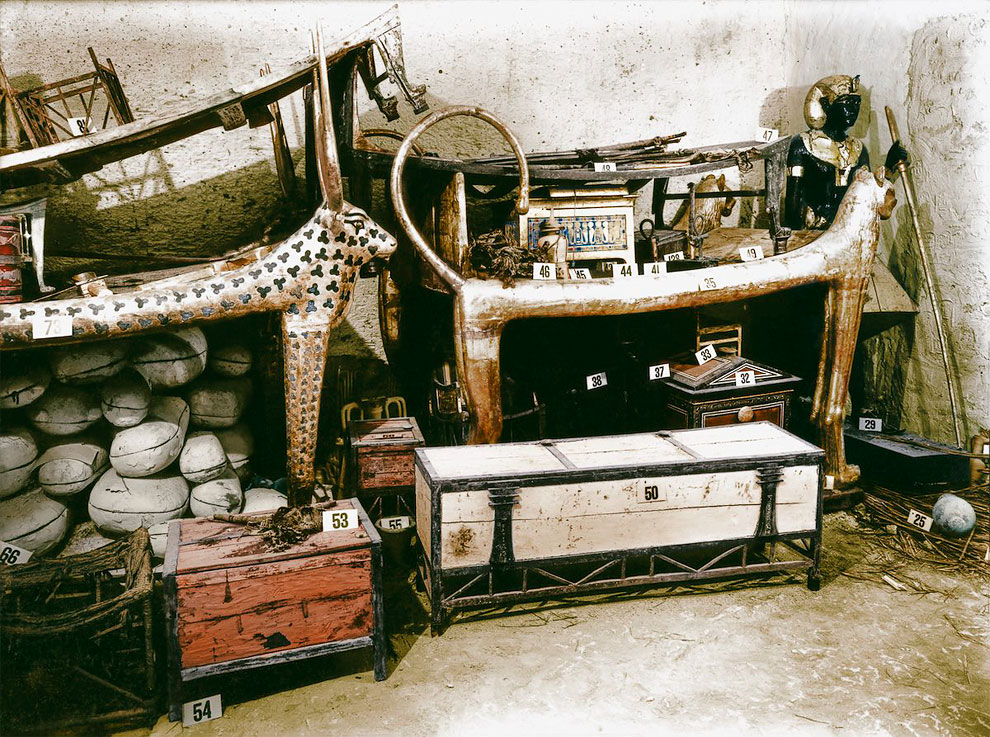
December 1923, Tutankhamun’s Tomb | The linen pall, decorated with bronze ‘rosettes’ (Carter no. 209) inside the walls of the first (outermost) golden shrine (Carter no. 207) in the north west corner of the Burial Chamber:
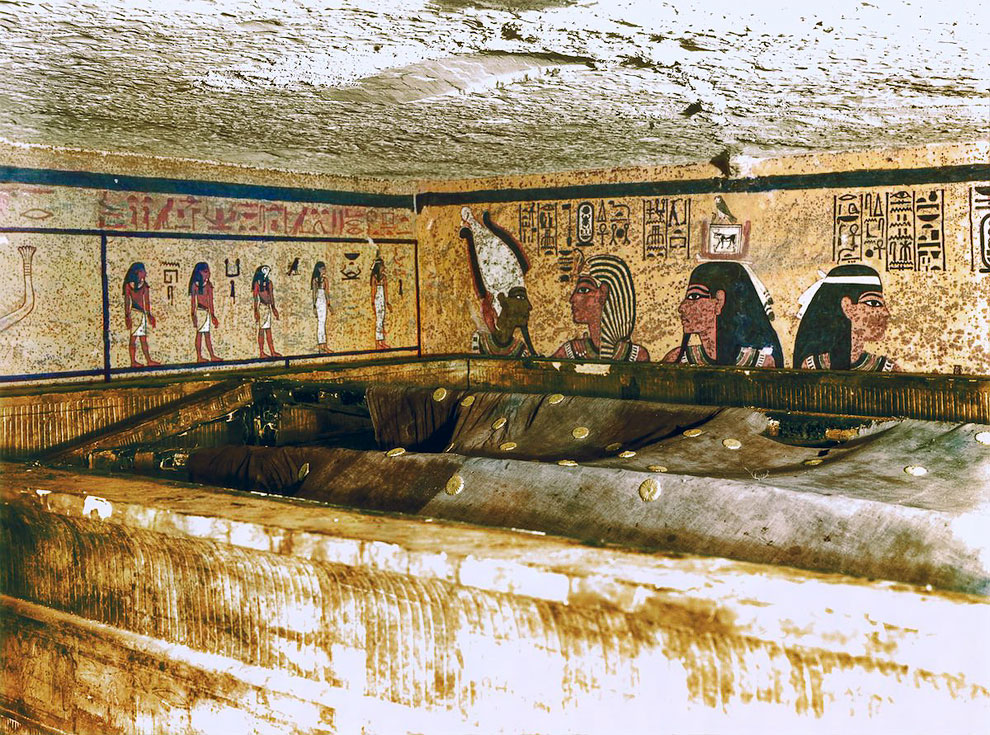
October 1926, Tutankhamun’s Tomb | A line of chests down the centre of the Treasury, ending with the canopic chest (Carter no. 266) which housed the king’s linen-wrapped stomach, intestines, liver and lungs in miniature gold coffins, inside an alabaster canopic box:

29th/30th October 1925, Tutankhamun’s Tomb | Carter and an Egyptian workman examine the third (innermost) coffin (Carter no. 255) made of solid gold, inside the case of the second coffin. (Carter no. 254):

December 1922, Tutankhamun’s Tomb | Objects, including the cow-headed couch (Carter no. 73) and boxes containing joints of meat (Carter nos. 62a to 62vv) piled up against the west wall of the Antechamber:
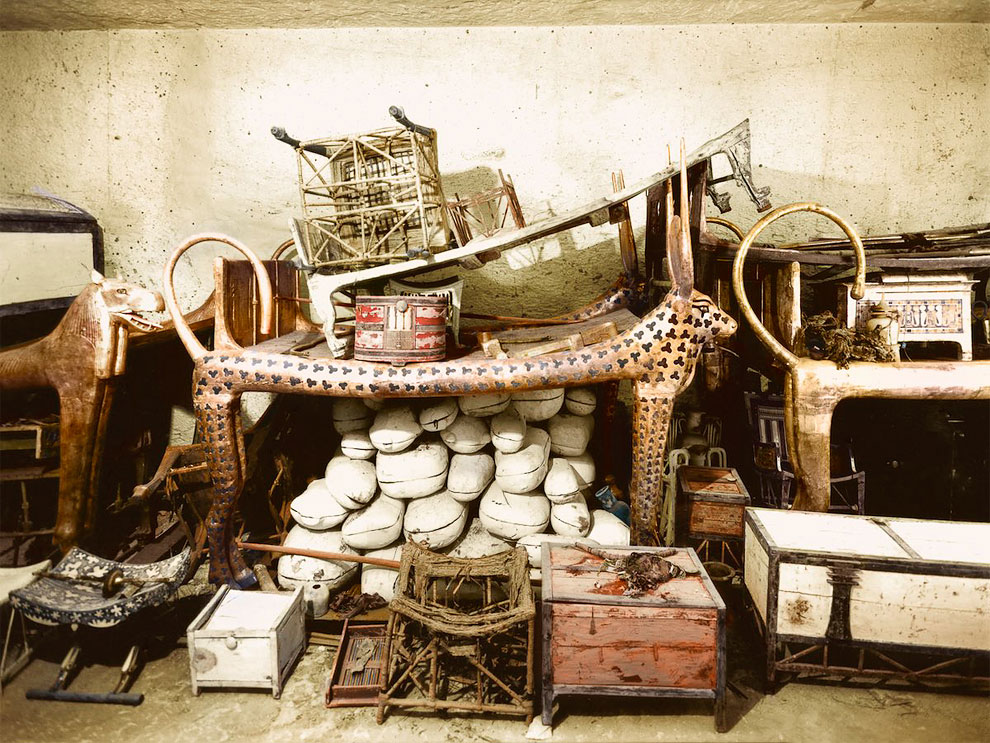
October 1926, Tutankhamun’s Tomb | Three wooden chests (the middle one in the shape of a cartouche) on the floor of the Treasury (Carter nos. 267, 269 and 270). Amongst other items these contained earrings, sandals and a wax model of a heron:

October 1925, Tutankhamun’s Tomb | Howard Carter working on the lid of the second (middle) coffin, still nestled within the case of the first (outermost) coffin in the Burial Chamber:

November/December 1923, Sethos II’s Tomb (‘laboratory’) | Arthur Mace (left) and Alfred Lucas working outside the ‘laboratory’ set up in the tomb of Sethos II (KV 15), stabilizing the surface of one of the state chariots (Carter no. 120) found in the Antechamber:

30th December 1923, Tutankhamun’s Tomb | Howard Carter (left), Arthur Mace and an Egyptian workman standing on scaffolding, roll back the linen pall (Carter no. 209) which lay over a gilded, wooden frame (Carter no. 208) between the first (outermost) and second shrines:
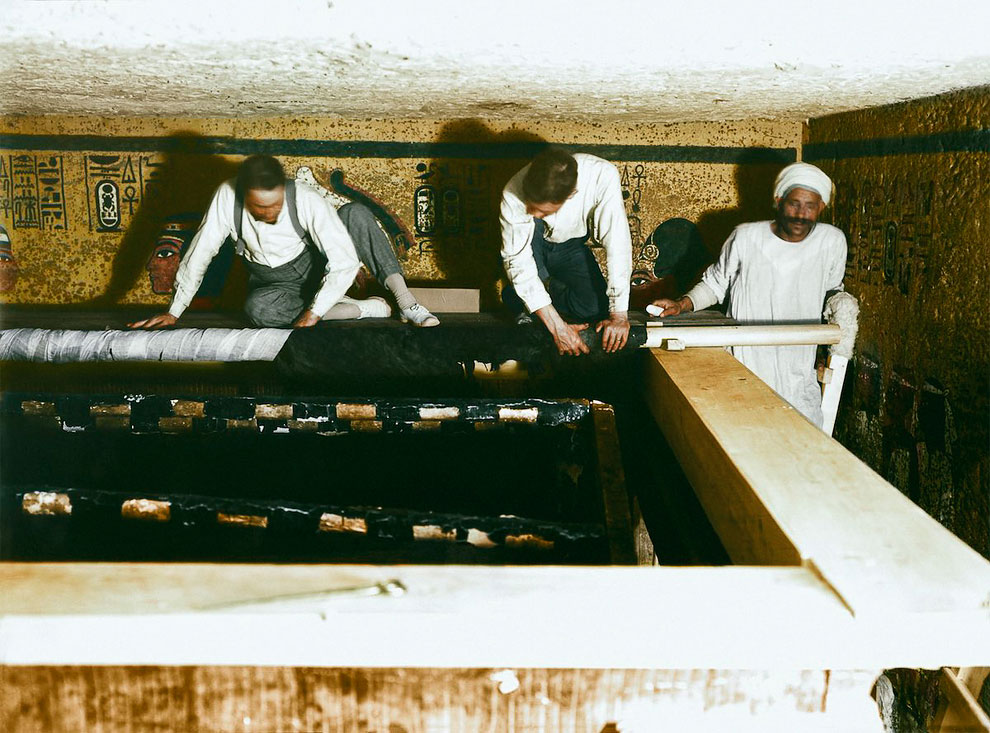
November 1926, Tutankhamun’s Tomb | Objects, including numerous model boats (Carter nos. 284 to 287), stacked against the southern wall of the Treasury:
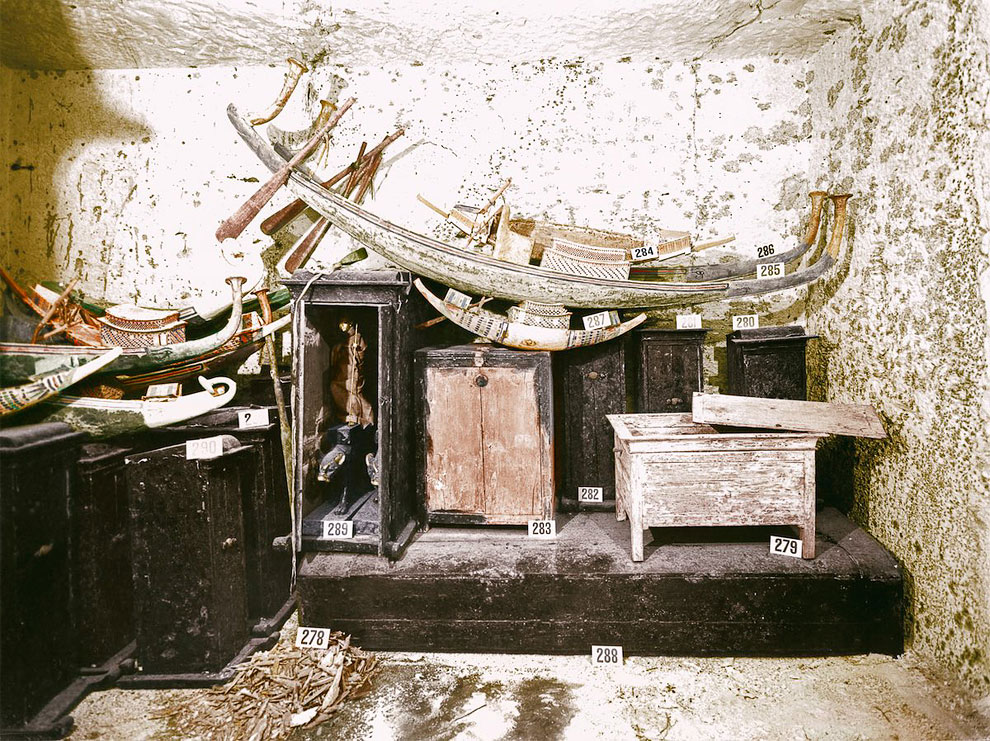
December 1922, Tutankhamun’s Tomb | Sealed alabaster ‘unguent’ vases (Carter nos. 57, 58, 60 and 61) between the cow-headed (Carter no. 73) and lion (Carter no. 35) couches against the west wall of the Antechamber:

October 1926, Tutankhamun’s Tomb | The Anubis shrine (Carter no. 261) on the threshold of the Treasury viewed from the Burial Chamber. The figure of Anubis was covered with a linen shirt inscribed with the cartouche of Akhenaten:
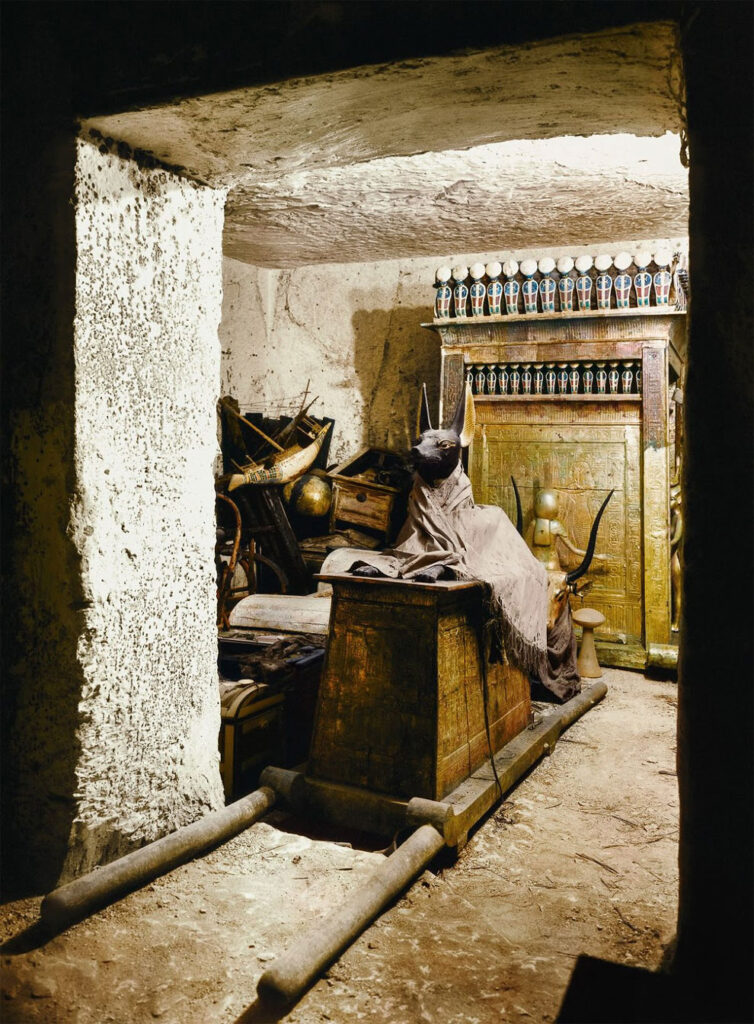
4th January 1923, Tutankhamun’s Tomb | Howard Carter (kneeling), Arthur Callender and an Egyptian workman in the Burial Chamber, looking through the open doors of the four gilded shrines towards the quartzite sarcophagus:
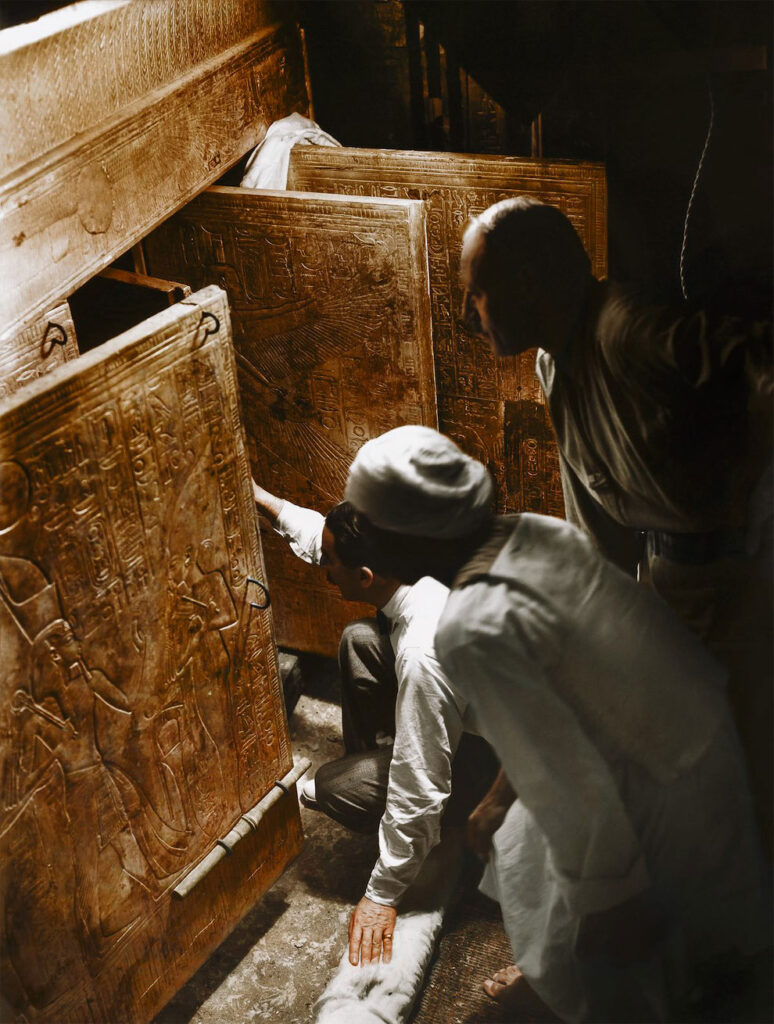
January 1924, Sethos II’s Tomb (‘laboratory’) | Arthur Mace (standing) and Alfred Lucas (sitting) working inside the makeshift ‘laboratory’ (set up in KV 15, the tomb of Sethos II) on the conservation of one of the two sentinel statues from the Antechamber (Carter no. 22). The statue shows the King wearing the nemes headdress, kilt and sandals, and carrying a mace and a staff:
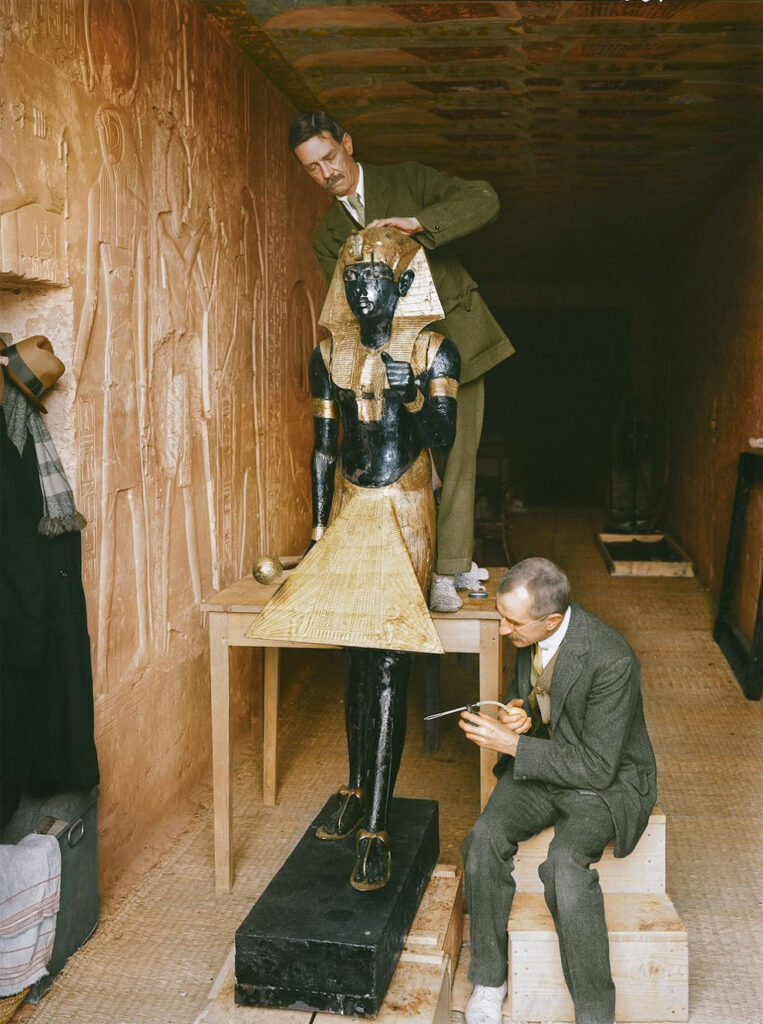
29th/30th October 1925, Tutankhamun’s Tomb | The gold mask (Carter no. 256a) in situ on the mummy of the King, still inside the third (innermost) solid gold coffin (Carter no. 255):
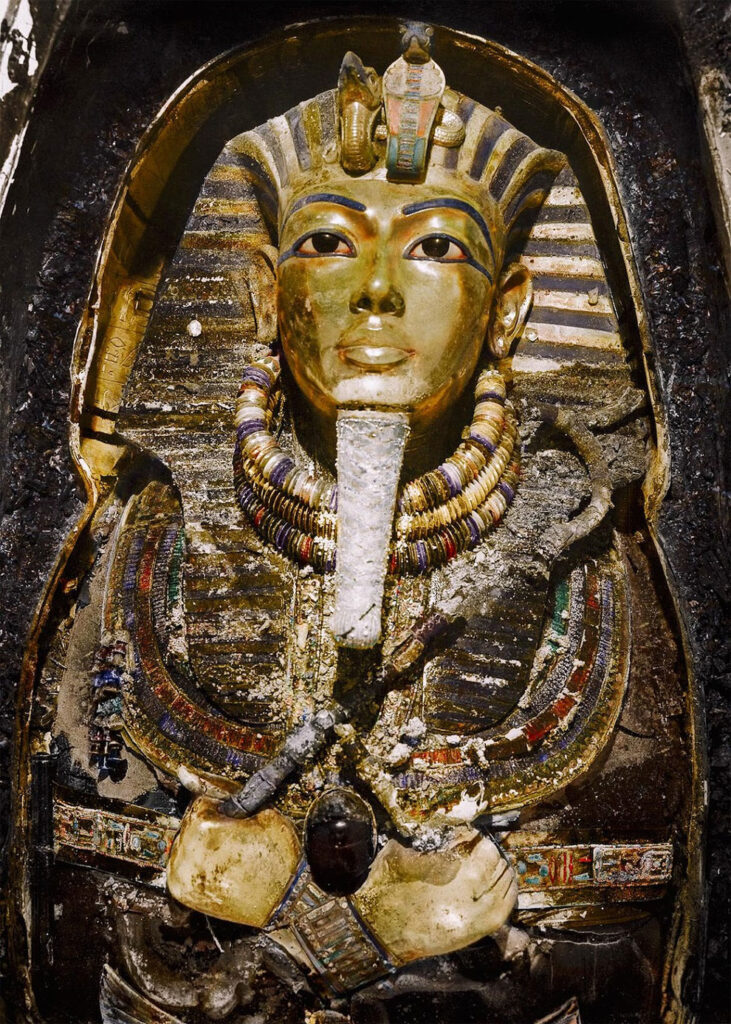
December 1923, Tutankhamun’s Tomb | Howard Carter (centre), Arthur Callender and two Egyptian workmen lifting one roof section from the first, outermost shrine (Carter no. 207). With its double sloping roof, the shape of this shrine resembles that of a ‘sed festival pavilion’; it was made of from twenty separate oak sections, held together by a variety of different joints:

2nd December 1923, Tutankhamun’s Tomb | Howard Carter (at the top of the stairs), Arthur Callender and Egyptian workmen removing the wall between the Antechamber and the Burial Chamber to enable the dismantling of the four golden shrines enclosing the sarcophagus:
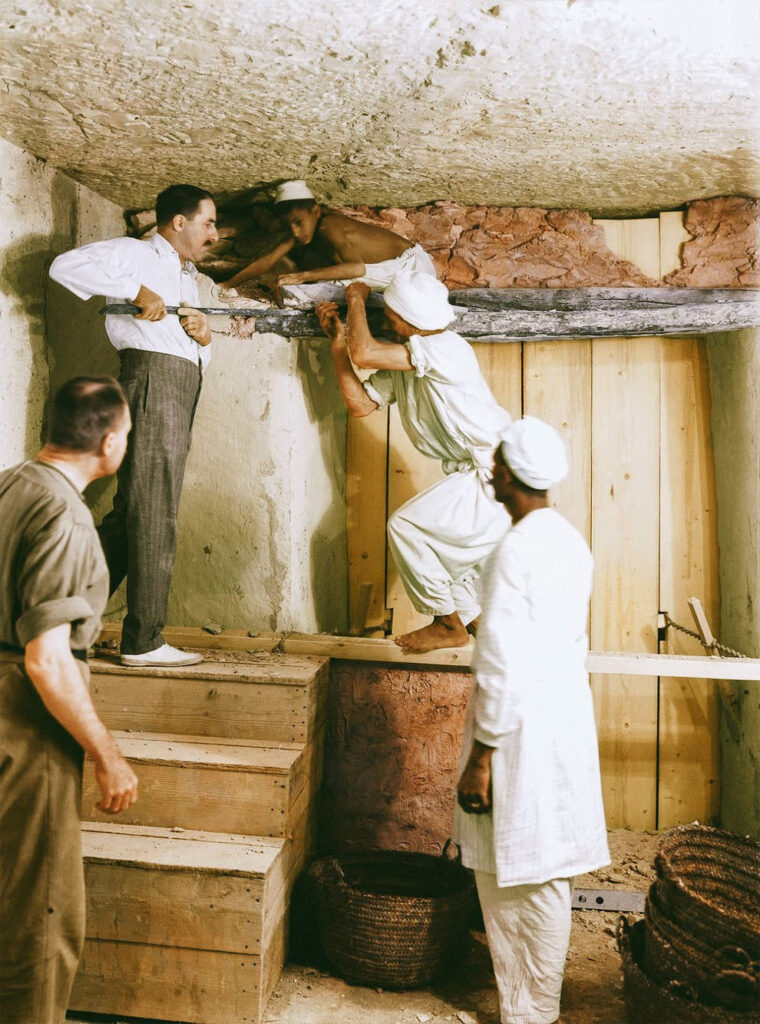
Herbert George Edward Stanhope Molyneux, 5th Earl of Carnarvon, reading on the verandah of ‘Castle Carter’, Carter’s house at Elwat el-Dibbân on the Theban West Bank:

China is economically defeating U.S. imperialism, Russia is militarily defeating it
Unless Washington’s provocations upset the dangerously unsteady balance it depends on, and lead to a third world war, the future of warfare between the U.S. and its geopolitical challengers will not primarily be based in the realm of international flare-ups like the “Chinese spy balloon” upset.
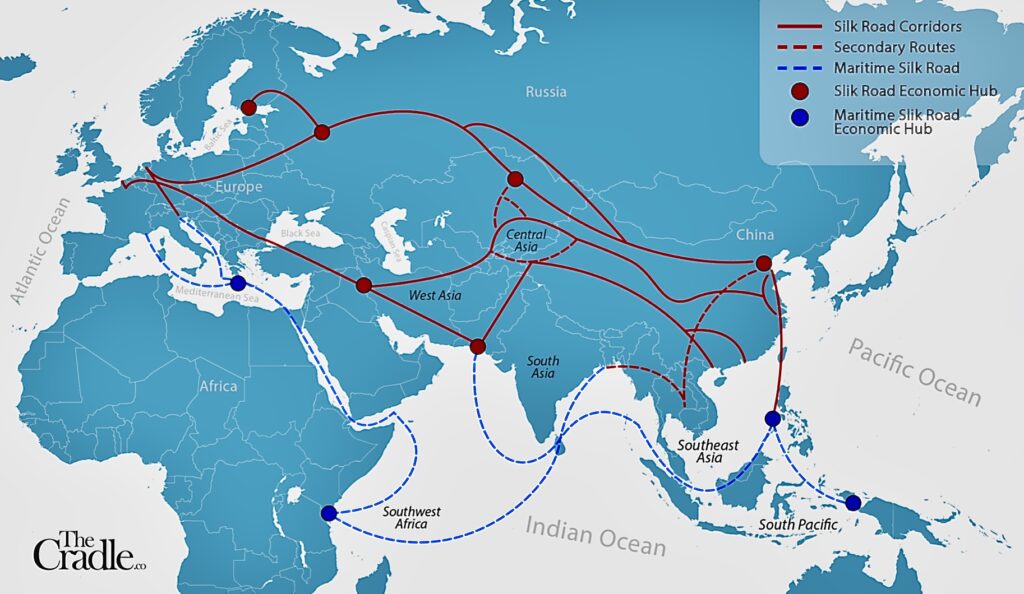
It will be based in a series of economic struggles that end with the imperialists losing trade dominance over Eurasia, and therefore losing their neo-colonial extractive sources.
The American war machine’s ruse of treating a benign Chinese aircraft as malicious, then shooting it down for dramatic effect, has had no impact on history other than provide another reason for China to be irritated at the USA.
And unless Washington oversteps in a way which it knows would lead to a crisis too big for it to handle, China and its other adversaries will never respond to Washington’s antics by escalating towards open war.
These kinds of stunts by the imperialists are nothing more than ways to narratively justify its militarism, sanctions, and war-related austerity, which the imperialists hope will reverse the transition towards multipolarity.
I find these manufacturings of drama on Washington’s part relatively uninteresting, because the psyop managers aren’t going to succeed at restoring U.S. hegemony.
Hyperbolic headlines about a balloon can’t undo a process of economic development and geostrategic realignment that’s been underway for decades, and that’s the natural evolution away from postwar unipolarity.
Over half a century after the 1963 film 55 Days at Peking created the famous quote “Let China sleep, for when she rises, the world will tremple,” we’re finally seeing what this rise was going to look like.
The anti-imperialist Pepe Escobar describes the extent of the ways the PRC is changing Eurasia’s economic orientation:
Acute supply chain decoupling, the crescendo of western hysteria over Beijing’s position on the war in Ukraine, and serious setbacks on Chinese investments in the west all play on the development of BRI 2.0. Beijing will be focusing simultaneously on several nodes of the Global South, especially neighbors in ASEAN and across Eurasia. Think, for instance, the Beijing-funded Jakarta-Bandung high-speed railway, Southeast Asia’s first: a BRI project opening this year as Indonesia hosts the rotating ASEAN chairmanship. China is also building the East Coast Rail Link in Malaysia and has renewed negotiations with the Philippines for three railway projects. Then there are the superposed interconnections. The EAEU will clinch a free trade zone deal with Thailand. On the sidelines of the epic return of Luiz Inácio Lula da Silva to power in Brazil, this past Sunday, officials of Iran and Saudi Arabia met amid smiles to discuss – what else – BRICS+. Excellent choice of venue: Brazil is regarded by virtually every geopolitical player as prime neutral territory.
Even though the PRC, unlike the DPRK, has decided not to openly voice support for Russia’s anti-fascist war, Operation Z is why this project to economically undermine the empire has become so successful in the last year.
The foremost aim behind Washington’s provoking Russia into intervening was to weaken Russia enough that both the Russian Federation and the PRC could get successfully defeated by imperialist schemes.
The calculus behind this was that when America and Europe used the geopolitical escalation to fully decouple from Russia, and ultimately China as well, the shock would be destructive enough to bring about this scenario of a destabilized Eurasia.
Which depends on the assumption that the imperial powers, after their half a millennium of extracting from the colonized and formerly colonized peoples, consequently have the capacity to crush Eurasia’s emerging superpowers. That their past successes at destroying other societies guarantee they’ll keep being successful at it.
This hubris, and the desperate self-deception it requires, was shown when the EU’s foreign policy chief Josep Borrell declared after the sanctions had proven insufficient this fall:
“The world needs Europe…Most of the rest of the world is a jungle, and the jungle could invade the garden.”
These are the words of somebody who’s just lost, and lost in a final sense.
The failure of the sanctions to bring about their objective represents a vast, fruitless sacrifice on the part of the imperial power structure. The campaign to economically isolate Russia and China has destroyed the social stability of the imperialist countries, driving down living standards as shocks devastate the working classes within these places.
Now our ruling class faces a greater danger than ever of uprisings, without having gained the geopolitical victories this destruction was supposed to bring.
The plan was for Americans and Europeans to economically suffer in the short term so that the empire could win on the Eurasian geopolitical chessboard, restoring neo-colonial extraction and ultimately bringing back social stability within the core countries.
Instead what the imperialists have gotten is a crisis for the core which will never end, not so long as workers revolution in the core is delayed.
Intensified austerity and repression is all the core’s proletariat can expect until they manage to overthrow their bourgeois dictatorship.
The only logical outcome, at least if the workers movement gains enough strength, is the end to the rule of our oligarchy.
Because more and more are coming to recognize this reality that their circumstances can only change if they smash the state that keeps capital in power.
This has been true since the beginning of capitalism, our socioeconomic system was always doomed to fail.
With this dual war against imperialism waged by the Russians and the Chinese, the process of capitalist decline is accelerating.
This is true both in the places the imperial ruling class still controls, and in Russia, which is run by a less economically powerful oligarchy.
As Russia’s neoliberal system proves unable to provide for the people’s needs during wartime, the war has sidelined the fascists within Russia’s government, while giving more power to the communists; it was the communists who helped pressure Putin into taking action against Ukrainian fascism, and into therefore solidifying Russia’s role as a challenger towards imperialism.
As present trends go, they’re gaining the leverage to carry out a Bolshevik revolution 2.0.
The equivalent is true in Belarus, where the communists hold great influence over a bourgeois state that’s assisting Russia in the anti-fascist war.
This successful joint attack against the empire is why China’s BRI has become as effective as it now is.
Z has prompted Russia to strengthen its ties with China, and ease the PRC’s project of lifting the peripheral countries out of poverty.
Under even the least optimistic of circumstances, the acceleration of the transition to multipolarity that Operation Z represents will without a doubt bring the defeat of U.S. imperialism as a globally hegemonic force.
And should the class struggle sufficiently succeed worldwide, we’ll see both a restoration of the Soviet Union and a new wave of revolutions across the peripheral countries, which are through the BRI gaining the economic strength to no longer be controlled by the empire.
What could ultimately come is revolution in the core countries as well, and with it the end of capital’s ability to coerce any of the historically colonized countries into submission.
The bourgeoisie will have lost almost definitively, and as long as the future socialist states maintain commitment to class struggle, the bourgeoisie will then be able to go extinct as a social class.
China Satellites Firing Green Lasers Over Hawaii

People on the Hawaiian islands have noticed barrages of green laser light being fired down at them from space at night. Turns out, the lasers are coming from Chinese Satellites in space – on purpose.
China claims they are scanning for “air pollution.”
Above the islands of Hawaii on January 28, a green laser was seen piercing the night sky, silently tracing a path towards the horizon like a stutter in the Matrix’s code.
The scene was caught on camera from a telescope atop Hawaii’s tallest peak.
Originally, experts at the National Astronomical Observatory of Japan (NAOJ), which co-owns the camera, announced on Twitter that the green light probably came from a radar device on an orbiting satellite, known as ICESat-2.
ICESat-2 is owned by NASA, and it’s used to keep an eye on the thickness of Earth’s sea ice, ice sheets, and forests.
But on 6 February 2022, NAOJ updated their footage of the laser beam saying that based on the trajectory, it was unlikely to be NASA after all.
“According to Dr. Martino, Anthony J., a NASA scientist working on ICESat-2 ATLAS, it is not by their instrument but by others,” a note on the YouTube video explains.
“His colleagues, Dr. Alvaro Ivanoff et al., did a simulation of the trajectory of satellites that have a similar instrument and found a most likely candidate as the ACDL instrument by the Chinese Daqi-1/AEMS satellite.
“We really appreciate their efforts in the identification of the light. We are sorry about our confusion related to this event and its potential impact on the ICESat-2 team.”
China’s Daqi-1 satellite was launched in April last year and similar to ICESat-2, it’s an atmospheric environment monitoring satellite.
That means it’s in orbit around Earth in order to monitor global carbon levels, as well as atmospheric pollution.
Daqi-1 contains five instruments to help it do this, including ACDL, which stands for Aerosol and Carbon dioxide Detection Lidar.
Lidar is an acronym for laser imaging, detection, and ranging, and it works a little like sonar. But instead of sending out sound waves to map an area, it sends out laser beams.
And it’s these lasers that are believed to have lit up the sky over Hawaii at the end of January.
In the case of ACDL, it can send out dual-wavelength lasers at specific wavelengths in order to detect various molecules in Earth’s atmosphere.
The time it takes for these laser beams to bounce back provides information on the composition of the atmosphere and ground below.
For example, ACDL can work out how much CO2 is in Earth’s atmosphere by emitting two alternating lasers around the 1572 nanometer wavelength range.
“Daqi-1 can monitor fine particle pollution like PM2.5, pollutant gasses including nitrogen dioxide, sulfur dioxide and ozone, as well as carbon dioxide concentration,” a March 2021 press release from the China Aerospace Science and Technology Corporation, which developed Daqi-1, explained.
It’s early days for Daqi-1 so we’re still waiting for results from its scans.
But if all goes to plan, the satellite is just the start of China’s plans to keep tabs on air pollution.
“China will produce a series of Daqi satellites in the future, which will be used to monitor atmospheric pollution, provide remote sensing data support for environment authorities, and also support scientific research into global climate change,” the March 2021 press release explained.
“Daqi-1 will be networked with other satellites, including Daqi-2, to realize greenhouse gas monitoring and help China achieve reduction of carbon emissions.”
It’s yet to be seen whether these green atmospheric detecting lasers may become more common as China achieves this goal.
Below is the satellite map of Earth, from U.S. Satellites which track actual pollution. The area circled in red is eastern China. Maybe they would do better if they started “studying” in their own country?

No War With China
February 6, 2023
You might think that provoking nuclear war with Russia would be enough for brain-dead Biden and his gang of neocon controllers. But it isn’t. They want nuclear war with China too. The Chinese government regards Taiwan as part of China, but it hasn’t tried to take it over militarily. Biden decided this isn’t good enough. He warned the Chinese that if they use force against Taiwan, the US will use force against them. This risks nuclear war.
Michael D. Swaine, an authority of Chinese-American relations who has advised the State Department, explains what is going on in an article that was published in The Diplomat, January 23: “The past year has seen a significant escalation in tension between Washington and Beijing over Taiwan, with many strategists warning that China seems poised to invade the island. In order to preserve U.S. interests, they argue, Washington must rely primarily, if not entirely, on military deterrence.
But this strategy would almost certainly backfire. Rather than preventing a war with China over Taiwan, a policy centered on military deterrence could spark one.
Those who advocate an approach based almost exclusively on deterrence believe China aspires to replace the United States as the dominant regional power in Asia through largely military means. Seizing Taiwan by force or intimidation, they say, is a necessary first step toward subjugating other Asian nations, including U.S. allies like Japan. They believe that once it has gained broader military access to the Pacific by controlling Taiwan and dominating other nearby powers, China could then go on to threaten Hawaii and the continental United States.
According to this analysis, the only option for the United States is to double down on its military presence in the region, push its allies to greatly increase their defense spending and support for the U.S. stance, and move closer to Taiwan both politically and militarily, making it a de facto security ally in Asia. The clear implication is that Taiwan, as a critical strategic location, must never be unified with China.
But this approach to the Taiwan situation is based on a very dubious analysis of both Taiwan’s purported strategic value and China’s regional intentions.
In fact, despite the views of some American and Chinese defense analysts today, historically, neither Washington nor Beijing have ever regarded Taiwan as a key strategic linchpin in the region. For China, reunification with Taiwan is above all else an issue of territorial integrity and national pride; as such, it is critical to the legitimacy of the Communist Party regime in the eyes of its people. For the United States, Taiwan is linked to Washington’s credibility as a loyal supporter of a democratic friend and an ally to others such as Japan and South Korea.
From a purely military perspective, it is highly problematic to assert that control over Taiwan would give Beijing decisive leverage over Japan, South Korea, or other Asian countries, much less the United States. And there is no clear evidence to show that China believes its security depends on militarily defeating or intimidating its Asian neighbors.
Moreover, while some Asian countries are certainly hedging against China’s growing military power and the danger of a Sino-American conflict by increasing their defense spending, the region as a whole is more worried about economic issues such as recovering from the pandemic, overcoming recession, and promoting sustainable growth through continued close economic ties with both the United States and China.
For the United States, a deterrence policy predicated on keeping Taiwan separate from China for strategic reasons is totally incompatible with its one China policy, whereby Washington opposes any unilateral move toward Taiwan independence, maintains strategic ambiguity regarding its defense of Taiwan, and remains open to the possibility of peaceful, uncoerced unification. This position remains the core of the understanding reached in 1972, which formed the basis of the normalization of Sino-American relations, in which the U.S. acknowledged the Chinese position that Taiwan is part of China while Beijing stressed that peaceful unification would be a top priority of its cross-strait policy.
If the United States were to abrogate that critical understanding by, for example, extending diplomatic recognition to Taiwan, or making the island into a full–fledged security ally (as the deterrence-only approach advocates), China would without doubt respond by dropping its part of the understanding and proceed to reverse any such U.S. actions by all means necessary, including military force. The PRC government’s legitimacy in the eyes of its citizens would simply not survive if Beijing failed to respond to such a basic challenge to its nationalist credentials.
Equally significant, China’s leaders would almost certainly resort to force even if the U.S. enjoyed superior military deterrence capabilities, a point that is apparently not fully grasped by proponents of the deterrence-only approach. Given the incredibly high political stakes involved, even a failed effort to forcibly prevent the loss of Taiwan would be viewed in Beijing as favorable to doing nothing. The latter would almost certainly result in a severe domestic crisis, putting at risk not only the personal positions of China’s leaders but the stability of the entire PRC regime.
The Biden administration seems to be inviting such desperate Chinese calculations with its erosion of the one China policy and its growing reliance on aspects of the deterrence-only approach to Taiwan.
President Joe Biden has said repeatedly that the United States will intervene militarily if China attacks Taiwan, thereby treating the island as a sovereign security ally. He has also asserted that Taiwan alone must decide whether it should be independent, which denies the long-standing U.S. stance of opposition to any unilateral move toward Taiwan independence.
The government has also designated Taiwan as a non-NATO U.S. ally, giving it a status similar to sovereign nations with which it has formal security ties. It has sent senior U.S. officials to Taiwan under quasi-official conditions and sought to pressure countries against shifting their diplomatic representation from Taiwan to China, despite Washington having taken exactly the same action in 1979. And one senior U.S. defense official recently indicated in congressional testimony that Taiwan is indeed a critical U.S. strategic node central to its entire defense position in the Western Pacific, implying that the United States would be opposed to Taiwan uniting with China under any circumstances.”
It does not help matters that a U.S. General predicted on January 27 that war with China was likely by 2025: “A U.S. general said in a memo on Friday that he believes the country will be at war with China by 2025, according to several outlets that obtained a copy of the communication.
‘I hope I am wrong,’ Gen. Mike Minihan, a four-star Air Force general who leads the Air Mobility Command (AMC), said in the memo to troops under his command, which was first reported by NBC News.
However, he added: ‘My gut tells me we will fight in 2025. [Chinese President] Xi [Jinping] secured his third term and set his war council in October 2022. Taiwan’s presidential elections are in 2024 and will offer Xi a reason. United States’ presidential elections are in 2024 and will offer Xi a distracted America. Xi’s team, reason, and opportunity are all aligned for 2025.’
Minihan told AMC personnel to accept some increased risk in training as they prepare for the ‘China fight’ and sometime in February to ‘fire a clip into a 7-meter target with the full understanding that unrepentant lethality matters most. Aim for the head.’”
You might ask, how can brain-dead Biden be so stupid that he provokes war with both China and Russia? But that is just the point. Biden wants to block any challenge to American global hegemony. As the Strategic Culture Foundation noted nearly two years ago, “Similar to the Ukraine, the Biden administration’s rhetoric and conduct is serving to fuel an ever-more provocative stance by the Taiwanese leaders. This week, a senior official warned that the island’s forces would shoot down Chinese aircraft that approach the territory. This is nothing but a flagrant challenge to China’s territorial integrity and sovereignty. As in the case of the Ukraine and Russia, it is Washington’s words and actions that are inflaming the tensions between Taiwan and China. Yet the Americans accuse others of ‘aggression’ and claim to be providing ‘defense’.
The bigger picture for all of this is, of course, the geopolitical great game which Washington sees as a zero-sum challenge. Strategists in Washington have made it abundantly clear that the American imperative for pursuing its ambitions for global power and dominance is to prevent the rise of Russia and China and a multipolar world order. . . It is therefore logical, if not execrable, that Washington appears to be accelerating on a collision course against Russia and China. The speed and recklessness is correlated with the growing sense that the American Empire is in terminal demise. The Ukraine and Taiwan are providing the U.S. with a two-prong attack against Russia and China and what Washington views as its last chance to grasp on to a world that is disappearing before its eyes. America’s reckless and delusional gambling is placing the world in an extremely dangerous situation. Its rulers and their political flunkies are flicking matches at a powder-keg.”
But if the US abandons its aggressive anti-China policy, doesn’t this also mean abandoning Taiwan? Pat Buchanan has the answer to this, in a column last September: “One wonders: If China invades and seizes Taiwanese-claimed and -occupied islands within sight of the Chinese coast, and Taiwan resists, what would Biden do?
In the Nixon-Kennedy campaign of 1960, JFK called it ‘unwise’ to take a risk of being dragged into war, which could lead to a world war, over islands like Quemoy and Matsu that were not strategically defensible.
If Beijing invaded and occupied islands a few miles right off its coast, and Taiwan resisted, would Biden send the Seventh Fleet to war with China?
The basic question raised by these Biden commitments to go to war with a China with a huge army and fleet, and in its own home region, is — why?
No U.S. president after Richard Nixon has challenged China’s claim that there is but ‘one China’ and Taiwan ‘is a part of China.’
How many battle deaths, how many war dead, are we willing to sacrifice to prevent Beijing taking political control of an island of 23 million Taiwanese 6,000 miles away from the United States?
We did not fight to prevent China from imposing its control on 7 million people of Hong Kong. Why then does the independence of 23 million Taiwanese justify a U.S. war with the world’s most populous nation?
And if we fought a war with China over Taiwan, what would be our long-term strategic goal?
Independence for Taiwan?
But did we not cede that in the 1970s with Nixon’s trip to China, his Shanghai Communique and Carter’s severing of relations with the Republic of China?”
We must do all we can to fight against brain-dead Biden’s efforts to start nuclear wars with Russia and China simultaneously.
The Coming Existential Threat: Do We Act in Common OR Is It Going To Be Every Man for Himself?
By Gilbert Doctorow via Gilbert Doctorow
I returned to Brussels on Sunday after a month of travels in exotic and warm lands south of the equator. The re-entry shock upon arrival in Belgium was a lot greater than the 27 degree Centigrade drop in outdoor air temperature. After a month of only very limited reception of Russian news, due to satellite issues and hotel service issues, last night I switched on Russian state television’s news and talk show “Sixty Minutes” on www.smotrim.ru and got a full blast of the current state of relations with the US, which are very close to Doomsday.
Allow me to share with you the key point, namely the soon to be announced changes to the Russian doctrine on first use of nuclear weapons and their new more precise red lines that have come about from the plans for Russia’s partition and destruction that seem to be aired daily on US television.
As usual, Yevgeny Popov, State Duma member and host of “Sixty Minutes,” put a lot of video segments from Western television up on the screen, including a lengthy statement by Lieutenant General Ben Hodges, former commander of all U.S. forces in Europe from 2014 to 2017, on how the Ukrainians must be given long range precision missiles for them to attack Russian Crimea and also further into the Russian heartland. The interview from which this declaration was made does not yet appear in Google search, but from interviews posted in 2022 it is clear that Hodges is no madman, and his statements must, as Popov said, be taken with utmost seriousness.
The context, of course, for the radical escalation now being discussed in the United States is the expectation of a massive Russian offensive to begin shortly as the anniversary of the Special Military Operation approaches. The imminent defeat of Ukrainian forces has focused minds in Washington.
One of the regular panelists on “Sixty Minutes” then faced the cameras directly and said that Russia’s nuclear doctrine is under revision in light of these aggressive plans being aired in the United States, so that Russia is headed towards a policy of ‘preventive’ tactical nuclear strikes, similar to what the United States has. Moreover, if Ukraine targets Crimea and heartland Russia, then Russia will respond according to plans now being laid down.
These plans foresee counter strikes against U.S military installations in Europe and in the Continental United States using hypersonic missiles.
The panelist calls for this threat of counter strikes in Europe and the US to be made public and explicit, so that no one is in doubt about what to expect from the Kremlin.
So here we are.
The Russians are stripping away the fiction of a proxy war and revealing the co-belligerent status of the US and its NATO allies in preparation for a kinetic war with NATO.
As our illustrious former President, a man of few words, would say: “Not good!”
Allow me also to share with my readership the bitter medicine that I just shared with our daughter: look for an escape hatch!
Either, as I fervently hope, there will be an anti-war movement in the USA, in Europe arising from the shock therapy news now developing with respect to the coming kinetic war between NATO and Russia, OR failing that, it will be every man for himself.
Back in 1937 there were Jews in Berlin who decided they could ride out the storm and stay put. There were others who took the first boats out, to England, to the US, to South America. All of us in the Northern Hemisphere now may be facing the same existential choice.
Gaeng Massaman Kai

This recipe is for Gaeng Massaman Kai. The “massaman” indicates that the recipe is of a “musselman” or islamic origin, and it probably owes something to early Portuguese influences, and is similar in concept to the “sour and hot” Goan style vindaloo dishes. By Thai standards this is usually a fairly mild curry, so I find it is a good starting point.
Two points should be made:
(1) the quantities are a guide only: if you like a spice use more, if you don’t, use less. If your favorite spice is missing, try adding some…
(2) the dish is cooked “when it is cooked”. The meat should be cooked until tender and the potatoes should be cooked thoroughly, but otherwise taste it and stop cooking when you are happy. As the British chef Keith Floyd remarked in a series about South East Asian cuisine, Thai charcoal burners don’t have thermostats. I would add that most Thai cooks have neither a wrist watch nor a clock in their kitchen (which is often the back yard of the house, or even the sidewalk in front of their door).
First you must prepare a massaman curry paste. This can be prepared in advance and stored in the fridge in a preserving jar for several weeks or even months.
Massaman Paste
- 10 to 20 dried red chiles
- 1 tablespoon ground coriander seed
- 1 teaspoon ground cumin
- 1 teaspoon ground cinnamon (from fresh bark)
- 1 teaspoon ground cloves
- 1 teaspoon ground star anise
- 1 teaspoon ground cardamom
- 1 teaspoon ground white pepper
- 4 tablespoons chopped shallots (i.e. the small red skinned onions)
- 4 to 6 tablespoons chopped garlic
- 2 (2-inch) pieces lemon grass stalk, sliced into thin rounds
- A cube about half an inch on a side of galangal root, roughly chopped
- 1 tablespoon kaffir lime skin (ordinary lime skin will do if you can’t get it)
- 1 tablespoon “kapi” (preserved shrimp paste – note this smells awful until after you cook it, but it is quite essential to the flavor)
To this you add a little salt: preferably about 1-2 teaspoons of fish sauce.
The galangal is roasted before use. The ground spices should preferably be fresh, in which case you should briefly toast them in a wok without any oil to bring out the flavor before grinding them.
The ingredients are blended to a fine paste (traditionally in a heavy granite mortar and pestle, but you can use a food processor just as well, and with far less effort). Note if you can get fresh red chiles you can usefully use them instead of the dried ones.
Curry
- About 1 pound of chicken (you can also use pork or beef), cut into the usual “bite size pieces”
- 3 cups coconut milk
- 2 tablespoons roasted peanuts (unsalted of course)
- 5 peeled, but whole, small onions
- 5 small potatoes, peeled and partly boiled
- 3 bay leaves
- 5 roasted cardamom fruits (i.e. the whole pod)
- A small piece of roasted cinnamon bark
- 3 tablespoons palm sugar (you can use a light brown sugar instead if you can’t get palm sugar)
- 3 tablespoons tamarind juice (this is the “sour” ingredient – you can use white vinegar instead if you can’t get tamarind juice. The juice is made by soaking tamarind paste in a little water then squeezing it out, and running it through a seize to extract the juice from the pulp)
- 3 tablespoons lime juice
- 1 to 3 tablespoon curry paste (above)
- About 1 to 3 teaspoons crushed garlic (optional)
Instructions
- Allow the coconut milk to separate and you will have about 1 cup of thick “cream” and two cups of thin “milk”. In a small saucepan bring the milk to a simmer and add the chicken or pork. If you are using beef you will need another two cups of milk. simmer the meat until it is beginning to become tender (beef takes longer, hence the additional milk).
- Put the coconut cream in a wok and bring to a boil, add the massaman paste and “stir fry” until the flavor is brought out and maximized. The coconut oil will separate out and can be skimmed off with a spoon or ladle. (this removes much of the vegetable cholesterol or whatever it is called, and makes the dish much less trouble for those watching their weight or heart).
- Add the remaining cream and curry paste to the meat.
- Add the peanuts. Taste and adjust the flavor until it is (just) sweet (by adding sugar), sour and salty (by adding tamarind juice, lime juice and fish sauce).
- Add the remaining ingredients and cook until cooked.
- Note: The potatoes we use are a yellow fleshed sweet potato of the type sometimes called a yam in the US. Western style potatoes can be used, but absorb less of the sauce and flavor. The potatoes act as a “moderator” to reduce the heat of the curry, and should not be left out.
- You can either serve it on a bed of rice, or double the amount of potato and serve it alone.
- Accompany it with a dressed green salad and a bowl of pickled cucumbers. The traditional Thai table also offers chiles in fish sauce (Phrik nam pla) chiles in vinegar (phrik nam som or phrik dong), powdered chile (phrik phom – not to be confused with the powdered chile mix sold as chili powder in the US – it only contains chiles), sugar, and often MSG. You can if you wish add about a teaspoon of MSG to the above recipe to bring out the flavors, but I personally don’t think it is necessary.
And finally a word of warning to those who burn their tongues on the chiles: chile/curry cooked this way is oily – drinking water does not alleviate the burn; it spreads it around your mouth and throat. You should use a sweet effervescent beverage such as Coke, Pepsi or 7-Up to wash the burn away as quickly as possible. If you do not suffer the burn, I suggest you accompany the meal with a beer Singha is traditional, but any strong flavored lager type beer will do), or a robust red wine.

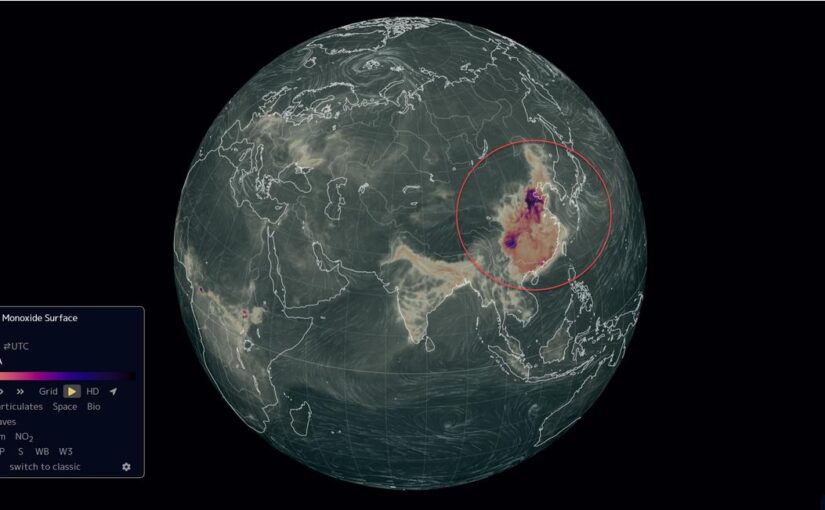

I fell on my left side a couple of days ago.
I was riding my bike when an SUV door opened in front of me. I hit it, then I fell to my side on the street. There was a sedan just meters behind me, but it stopped in the nick of time. I only got away with an injured left arm. No brain damage, no dislocations.
It’s healing up fast kudos to my Affirmations. Should be able to get back to exercising soon.
Now, to be on topic with this article.
The fact that they are fomenting all this warmongering and hatred towards China and Russia coincides with your prediction that this year, 2023, is going to be the year that the Western Ship finally sinks. I can feel the terror and worry everywhere I go as people check out the news and see all the decay happening domestically and internationally as well.
Be well. take care.
Stay safe ANTI. Always be cognizant of your surroundings, especially in that big city you reside in. Head on a swivel, as they say in the .mil. My thoughts are with you, sir.
OG
(3) China condemns ‘US hegemony’, war crimes, CIA coups, 400 foreign interventions – YouTube